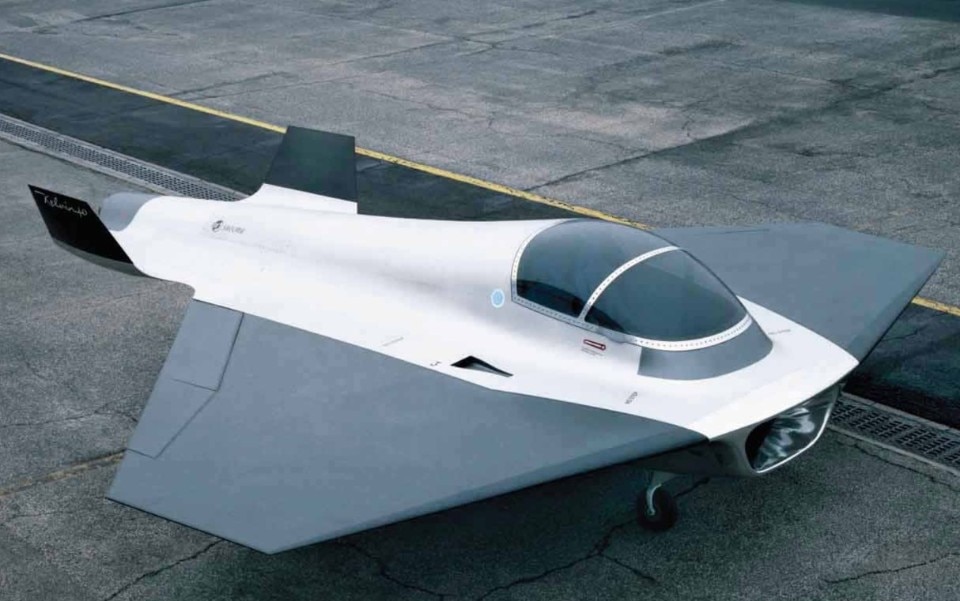Marc Newson has almost never denied himself one single area in which to push his research, in a vision of total and transversal design intersecting in many respects with that of the Bauhaus, and then contaminating it with expressive factors proper to the genesis of forms in art. Even the future of mobility, now a mainstream current topic, was a field of confrontation for him as early as 2004. But if today's news recounts Apple's retreats from nearly decade-long projects on self-driving electric vehicles, or the logistical deployment of superstars such as Taylor Swift becoming global memes, the thinking behind the K40 individual mini-jet that Newson presented at Fondation Cartier in Paris is that of democratized mobility that also included airspace, not a secondary perspective through which to look at a discourse that that would deeply and largely evolve in just a few years. Domus discussed this project with the designer in February of that year, on issue 867, in a feature suggestively titled Welcome to the Jet Age.
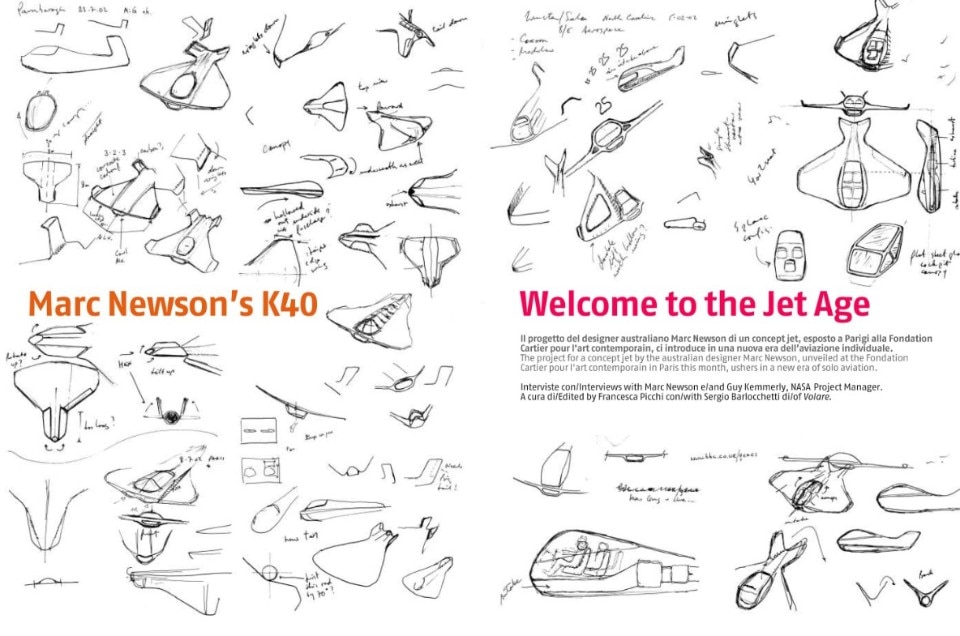
Mini Jets: the Car of the Future?
The project for a concept jet by the australian designer Marc Newson, unveiled at the Fondation Cartier pour l'art contemporain in Paris this month, ushers in a new era of solo.
As Marcel Dassault, the leading French aeroplane manufacturer, said: ‘For a plane to fly well, it must be beautiful’. In the year of festivities marking the first centenary of aviation, solo flight is once more being celebrated as one of the central themes of widespread mobility, but in its contemporary version: the mini-jet is the new means of mass transport. No longer trapped in the grid of an established system, restricted to obligatory routes (the hub-and-spoke pattern that means journeys must be broken up into an irregular sequence of long and short haul segments based on an inflexible hierarchy), freedom of movement is now being expressed in streaking mini-jets that offer a domesticated version of the fighter plane. The appearance of jets in commercial aviation after the war may have produced a luxurious image for an entire social category (the Jet Set), but the idea of solo aviation has to do with a far more pragmatic concept: luxury is freedom of movement. Although the fruit of a dream, Newson’s project conjures up a far more plausible reality than you would think. In the United States, the rise of the mini-jet is perceived as a true revolution in mass transportation. Aeronautical industries such as Cessna, ATG and Eclipse are soon planning to launch jets not much bigger than a saloon car on the market; these are intended mainly for business use but also for fun.
The affirmation of solo aviation as the spearhead of the national transport plan is supported by programmes such as SATS (Small Aircraft Transportation System), promoted by NASA. In 2001, the United States Congress presented a programme focusing on solo aviation that would reshape the national mobility system; just as the automobile brought legendary freedom of movement to the 20th century, so the mini jet - a lighter version of the great jet-planes that underpin commercial aviation - is the new symbol of democratic mobility.
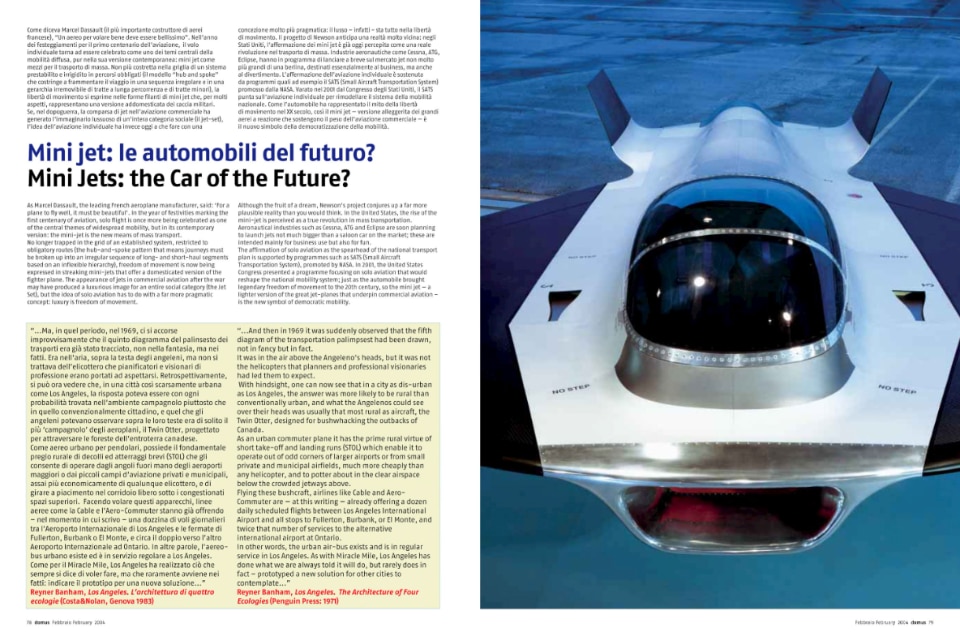
“...And then in 1969 it was suddenly observed that the fifth diagram of the transportation palimpsest had been drawn, not in fancy but in fact.
It was in the air above the Angeleno’s heads, but it was not the helicopters that planners and professional visionaries had led them to expect.
With hindsight, one can now see that in a city as dis-urban as Los Angeles, the answer was more likely to be rural than conventionally urban, and what the Angelenos could see over their heads was usually that most rural as aircraft, the Twin Otter, designed for bushwhacking the outbacks of Canada. As an urban commuter plane it has the prime rural virtue of short take-off and landing runs (STOL) which enable it to operate out of odd corners of larger airports or from small private and municipal airfields, much more cheaply than any helicopter, and to potter about in the clear airspace below the crowded jetways above. Flying these bushcraft, airlines like Cable and Aero-Commuter are – at this writing – already offering a dozen daily scheduled flights between Los Angeles International Airport and all stops to Fullerton, Burbank, or El Monte, and twice that number of services to the alternative international airport at Ontario. In other words, the urban air-bus exists and is in regular service in Los Angeles. As with Miracle Mile, Los Angeles has done what we are always told it will do, but rarely does in fact - prototyped a new solution for other cities to contemplate...” Reyner Banham, Los Angeles. The Architecture of Four Ecologies (Penguin Press: 1971)Reyner Banham, Los Angeles. The Architecture of Four Ecologies (Penguin Press: 1971)
Tell us about the K40. Does it really fly?
The first question everybody asks me is ‘Does it fly or not?’ For me this is not the point of the project, because this is a concept jet. It’s like a concept car – before a manufacturer makes a real car for production, it makes a concept car. To build a small jet is a dream that I had; ever since I was a kid I collected model jets and loved to watch airplanes taking off and landing at the airport. I was also looking for an interesting project to present at the Fondation Cartier. I already work for the aviation industry – 60% of my work is designing products and interiors for airplanes. I also have an interest in transport; I’ve designed a car and a bicycle. Seeing my contacts in the aviation industry, this is a project I could easily present at Le Bourget, at Farnborough, or other big air shows around the world, but I find it more attractive to present it within a cultural context. What you expect to see in a gallery is sculpture. And to me, an airplane is the summit of sculpture.
I read that you studied form with ONERA (The French National Aerospace Research Establishment), so you probably did wind tunnel tests. What were the results?
The things you discover in this kind of test are quite subtle - it won’t tell you if the airplane flies or not. It’s about optimization of form. Of course you can make anything fly - if you give me an engine that’s powerful enough, I can make a refrigerator fly. That’s not where the challenge lies. The challenge is to understand how to optimize the functionality of the form.
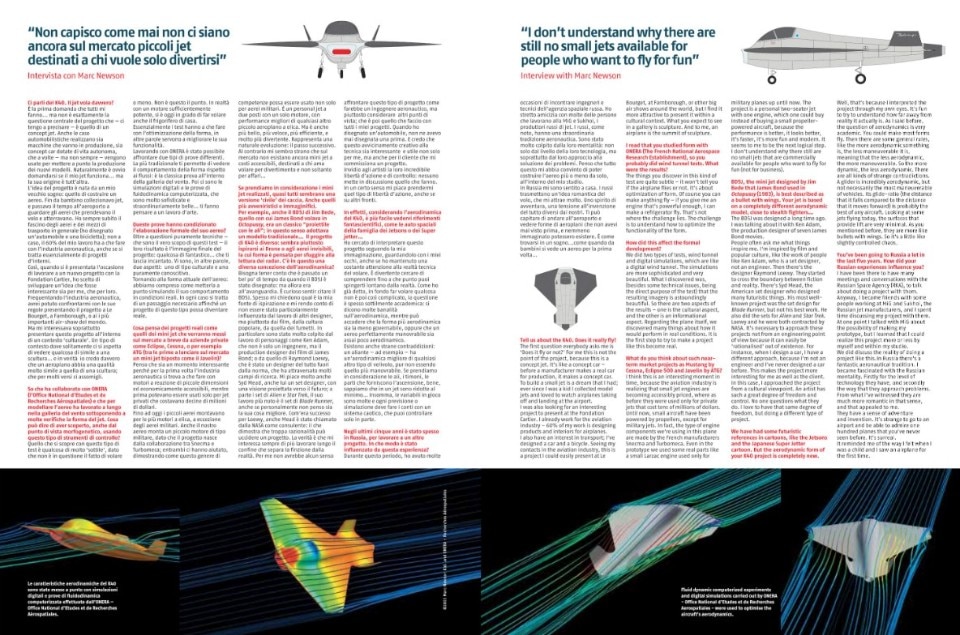
How did this affect the formal development?
We did two types of tests, wind tunnel and digital simulations, which are like a digital wind tunnel. The simulations are more sophisticated and very beautiful. What I discovered was, (besides some technical issues, being the direct purpose of the test) that the resulting imagery is astoundingly beautiful. So there are two aspects of the results - one is the cultural aspect, and the other is an informational aspect. Regarding the plane itself, we discovered many things about how it would perform in real conditions. It is the first step to try to make a project like this become real.
What do you think about such near-term market projects as Mustang by Cessna, Eclipse 500 and Javelin by ATG?
I think this is an interesting moment in time, because the aviation industry is realizing that small jet engines are becoming accessibly priced, where as before they were used only for private jets that cost tens of millions of dollars. Until now, small aircraft have been powered by propellers, except for military jets. In fact, the type of engine components we’re using in this plane are made by the French manufacturers Snecma and Turbomeca. Even in the prototype we used some real parts like a small Larzac engine used only for military planes up until now. The project is a personal two-seater jet with one engine, which one could buy instead of buying a small propeller-powered aircraft, because the performance is better, it looks better, it’s faster, it’s more fun and modern. It seems to me to be the next logical step. I don’t understand why there still are no small jets that are commercially available for people who want to fly for fun (not for business).
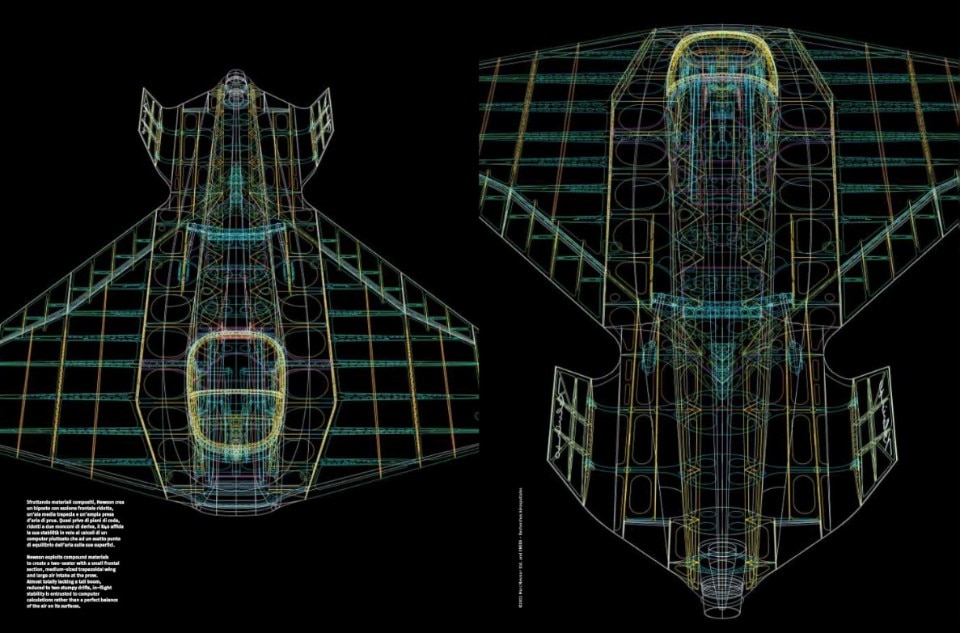
BD5J, the mini jet designed by Jim Bede that James Bond used in Octopussy (1983), is best described as a bullet with wings. Your jet is based on a completely different aerodynamic model, close to stealth fighters…
The BD5J was designed a long time ago. I was talking about it with Ken Adam, the production designer of seven James Bond movies. People often ask me what things inspire me. I’m inspired by film and popular culture, like the work of people like Ken Adam, who is a set designer, not an engineer. Then there’s the designer Raymond Loewy. They started to cross the boundary between fiction and reality. There’s Syd Mead, the American set designer who designed many futuristic things. His most well-known project was the set design for Blade Runner, but not his best work. He also did the sets for Alien and Star Trek. Loewy and he were both contracted by NASA. It’s necessary to approach these projects not from an engineering point of view because it can easily be ‘rationalised’ out of existence. For instance, when I design a car, I have a different approach, because I’m not an engineer and I’ve never designed a car before. This makes the project more interesting for me as well as the client. In this case, I approached the project from a cultural viewpoint. An artist has such a great degree of freedom and control. No one questions what they do. I love to have that same degree of freedom, but doing a different type of project.
We have had some futuristic references in cartoons, like the Jetsons and the Japanese Super Jetter cartoon. But the aerodynamic form of your K40 project is completely new.
Well, that’s because I interpreted the project through my own eyes. It’s fun to try to understand how far away from reality it actually is. As I said before, the question of aerodynamics is very academic. You could make most forms fly. Then there are some general rules, like the more aerodynamic something is, the less maneuverable it is, meaning that the less aerodynamic, the more maneuverable. So the more dynamic, the less aerodynamic. There are all kinds of strange contradictions. A glider is incredibly aerodynamic, but not necessarily the most maneuverable of vehicles. Its glide-ratio (the distance that it falls compared to the distance that it moves forward) is probably the best of any aircraft. Looking at some jets flying today, the surfaces that provide lift are very minimal. As you mentioned before, they are more like bullets with wings. So it’s a little like slightly controlled chaos.
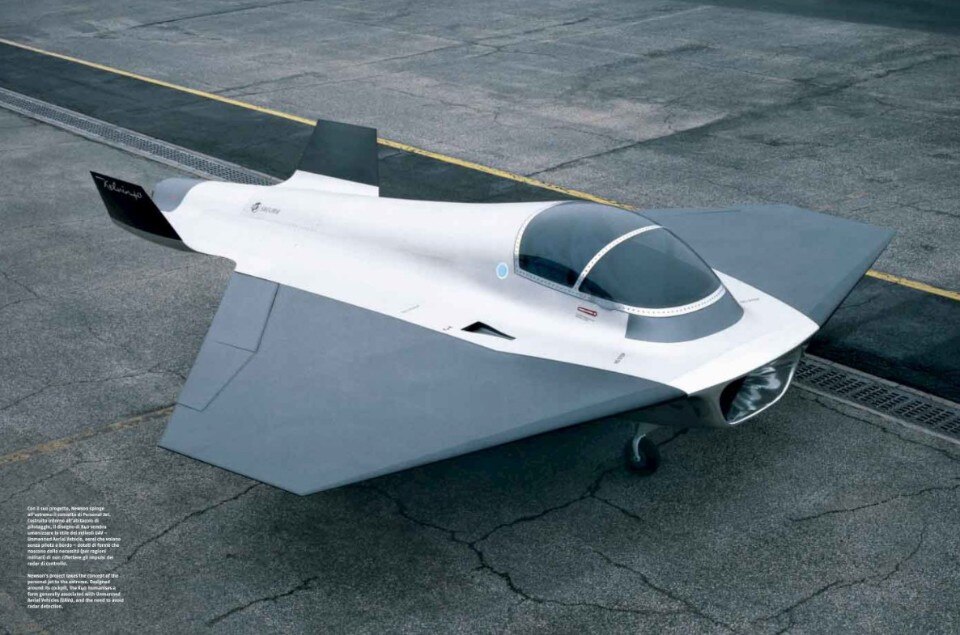
Can you give us NASA’s official view on SATS - Small Aircraft Transportation System (SATS) ? What are its key points?
We will be able to move people and goods faster and more efficiently from point to point through a system that is expected to reach full capacity by about the year 2015. At that point we expect that demand will exceed the capacity of the system as we currently manage it. The SATS project looks specifically at developing technologies that will allow an average pilot to operate in the high-traffic environment surrounding airports and to land in very low-visibility conditions - and do it comfortably. We describe our objectives as high-volume operations, lower landing minima and an increase in single-pilot performance, maintaining safety all along.
So the project is heavily dependent on technology.
In many cases we are actually taking existing technologies that have been developed for other projects and programmes, trying to adapt them for use in small aircraft. We’re also carrying out economic assessments and future projections to see how viable those technologies will actually be and what sort of impact they might have.
During the 20th century the notion of individual travel and transportation was revolutionized by the invention of the internal combustion engine. In your opinion, will developments in information technology bring about equivalent transformations in the 21st century?
Americans in general value freedom a great deal, and they associate freedom with the ability to move easily, which is why the automobile has had such a profound impact on American culture. We expect that these small aircraft, easily flown by average pilots, will be another big success. The first phase of implementation of the SATS vision will be an air-taxi service in which professional pilots will respond on demand to requests from the public. The expectation is that a family of four will be able to take approximately two vacation trips per year using this air-taxi service, even with an average middle-class income. This will probably be the case in about ten years. And for a family of four it would cost no more than airline tickets using the traditional system of hub-and-spoke airline travel. This would be point-to-point travel, from the local community airport to a community airport near the destination, at the same price as hub-and-spoke travel. Time spent for travelling would be greatly reduced, the schedule would be their own and the cost would be the same.
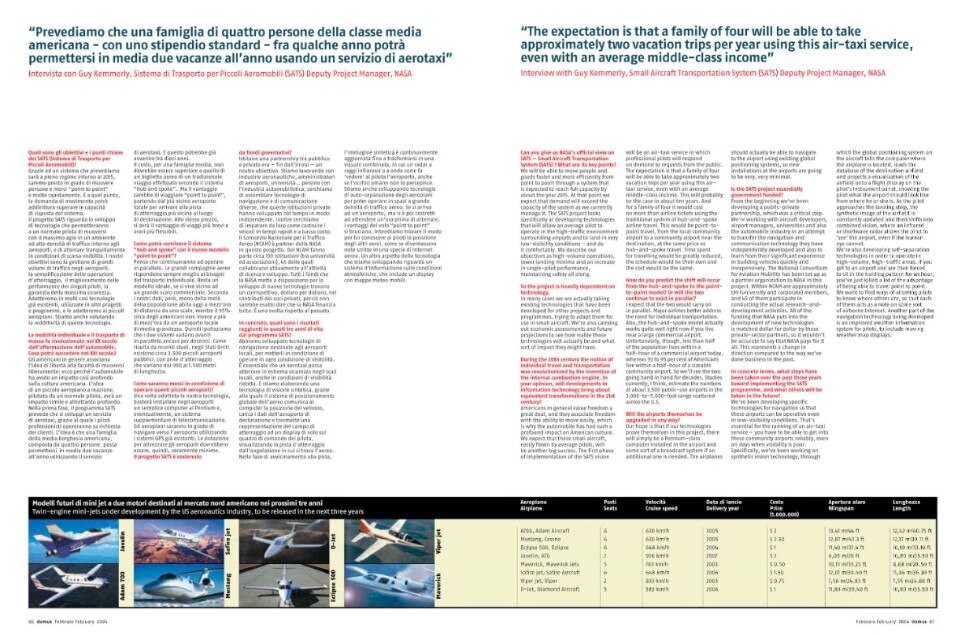
How do you predict the shift will occur from the hub-and-spoke to the point-to-point model? Or will the two continue to exist in parallel?
I expect that the two would carry on in parallel. Major airlines better address the need for individual transportation. Also, the hub-and-spoke model actually works quite well right now if you live near a large commercial airport. Unfortunately, though, less than half of the population lives within a half-hour of a commercial airport today, whereas 93 to 95 per cent of Americans live within a half-hour of a sizeable community airport. So we’ll see the two going hand in hand for decades. Studies currently, I think, estimate the numbers at about 3,500 public-use airports in the 3,000-to-5,000-foot range scattered across the U.S.
Will the airports themselves be upgraded in any way?
Our hope is that if our technologies prove themselves in this project, there will simply be a Pentium-class computer installed in the airport and some sort of a broadcast system if an additional one is needed. The airplanes should actually be able to navigate to the airport using existing global positioning systems, so new installations at the airports are going to be very, very minimal.
Is the SATS project essentially government funded?
From the beginning we’ve been developing a public-private partnership, which was a critical step. We’re working with aircraft developers, airport managers, universities and also the automobile industry in an attempt to transfer the navigation and communication technology they have independently developed and also to learn from their significant experience in building vehicles quickly and inexpensively. The National Consortium for Aviation Mobility has been set up as a partner organization to NASA in this project. Within NCAM are approximately 130 (university and corporate) members, and 45 of them participate in conducting the actual research-and-development activities. All of the funding that NASA puts into the development of new technologies is matched dollar for dollar by these private-sector partners, so it wouldn’t be accurate to say that NASA pays for it all. This represents a change in direction compared to the way we’ve done business in the past.
In concrete terms, what steps have been taken over the past three years toward implementing the SATS programme, and what others will be taken in the future?
We’ve been developing specific technologies for navigation so that these airports can be operative even in low-visibility conditions. That’s essential for the running of an air-taxi service - you have to be able to get into these community airports reliably, even on days when visibility is poor.
Specifically, we’ve been working on synthetic vision technology, through which the global positioning system on the aircraft tells the computer where the airplane is located, loads the database of the destination airfield and projects a visualization of the airfield onto a flight display on the pilot’s instrument panel, showing the pilot what the airport should look like from where he or she is. As the pilot approaches the landing strip, the synthetic image of the airfield is constantly updated and then shifts into combined vision, where an infrared or shortwave radar allows the pilot to ‘see’ the airport, even if the human eye cannot. We’re also developing self-separation technologies in order to operate in high-volume, high-traffic areas. If you get to an airport and are then forced to sit in the holding pattern for an hour, you’ve just killed a lot of the advantage of being able to travel point to point. We want to find ways of allowing pilots to know where others are, so that each of them acts as a note on some sort of airborne Internet. Another part of the navigation technology being developed is an improved weather information system for pilots, to include moving weather map displays.


